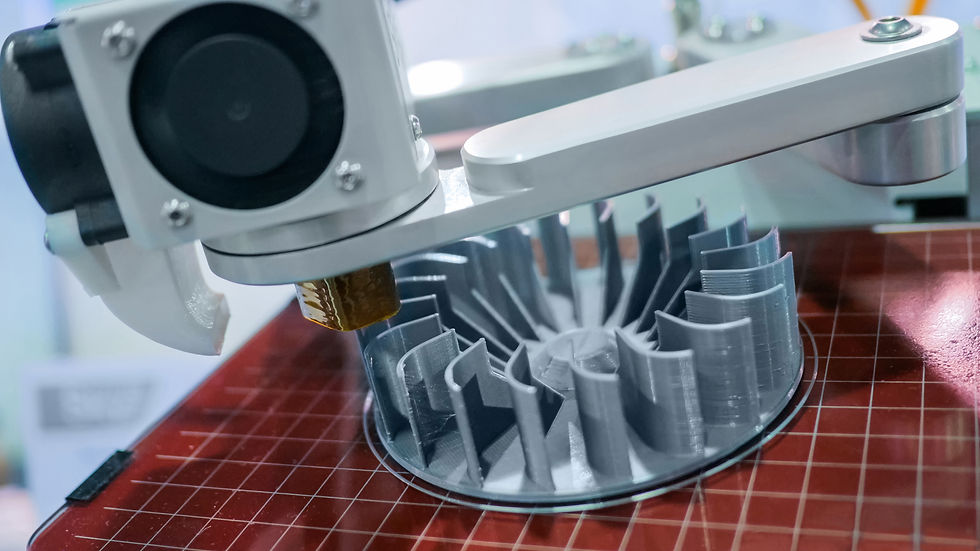Eco-Friendly Packaging: 3D Printing Replacing Traditional Plastics
- Dylan Brubacher
- Apr 2
- 3 min read
As businesses and consumers become more environmentally conscious, the demand for sustainable packaging solutions is on the rise. Traditional packaging materials such as foam inserts, molded plastics, and polystyrene contribute significantly to landfill waste and environmental pollution. However, 3D printing is emerging as a game-changing alternative for creating custom, eco-friendly packaging inserts that offer both protection and sustainability.
The Environmental Problem with Traditional Packaging Inserts
Foam and molded plastic inserts have long been used to protect fragile products during shipping, but they come with major drawbacks:
Non-biodegradable – Many of these materials take hundreds of years to decompose, leading to excessive waste in landfills.
Difficult to Recycle – While some plastics can be recycled, many foam-based packaging inserts are not accepted in most municipal recycling programs.
High Carbon Footprint – The production and transportation of molded plastics require significant amounts of fossil fuels and energy.
How 3D Printing Offers a Sustainable Alternative
3D printing, also known as additive manufacturing, is a low-waste, customizable solution that enables businesses to create packaging inserts that are both functional and sustainable. Here’s how:
1. Customization for Perfect Fit
Unlike traditional molded plastic inserts that require expensive tooling and molds, 3D printing allows for fully customized inserts tailored to fit each product perfectly. This reduces the need for excess packaging material and ensures better protection with less waste.
2. Use of Biodegradable and Recycled Materials
Many 3D printing materials are environmentally friendly, including:
PLA (Polylactic Acid) – A biodegradable plastic made from renewable resources like cornstarch or sugarcane.
Recycled Filaments – Some 3D printing companies offer filaments made from recycled plastics, reducing the need for virgin materials.
Bio-Based Resins – Plant-based resins are being developed as an alternative to traditional petroleum-based resins.
3. Reduced Waste Through Additive Manufacturing
Traditional manufacturing methods involve cutting or molding large sheets of plastic, often resulting in excess material waste. 3D printing, on the other hand, is an additive process—meaning material is deposited only where it is needed, significantly reducing waste.
4. On-Demand, Localized Production
With 3D printing, businesses can produce packaging inserts on-demand, reducing the need for large inventories and storage space. Additionally, localized production eliminates the need for long-distance transportation, cutting down on carbon emissions associated with shipping materials globally.
5. Lightweight and Durable Design
3D-printed inserts can be designed to be lightweight yet strong, reducing overall shipping weight and costs while maintaining the same level of protection as traditional packaging materials. Lattice structures, honeycomb patterns, and optimized geometries can be used to maximize strength while minimizing material use.
Real-World Applications
Many companies are already turning to 3D printing for sustainable packaging solutions:
Luxury brands use 3D-printed inserts for premium product packaging, eliminating foam while maintaining an elegant, customized look.
Electronics manufacturers are developing eco-friendly protective inserts to replace expanded polystyrene (EPS) and polyethylene foams.
E-commerce businesses are integrating 3D printing into their fulfillment centers to create custom-fit packaging on demand.
The Future of 3D-Printed Packaging
As 3D printing technology advances, the potential for sustainable packaging solutions will continue to grow. Innovations such as bio-based composite filaments, improved recycling methods, and faster printing speeds will make it even easier for companies to transition to eco-friendly packaging inserts.
By adopting 3D printing for packaging, businesses can reduce waste, lower their carbon footprint, and meet the growing demand for sustainability—all while delivering high-quality protection for their products. The future of packaging is not just about protecting what’s inside—it’s about protecting the planet as well.
.png)


